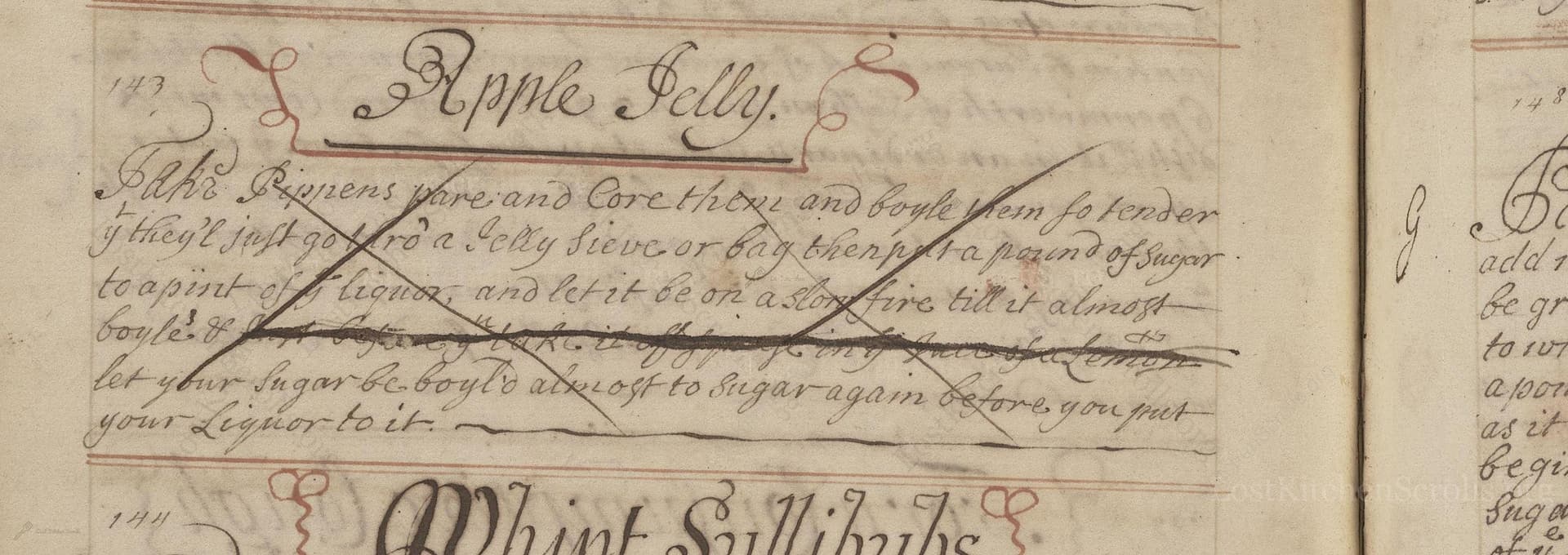Apple Jelly
From the treasured pages of English cookery and medicine book,
Unknown Author

Apple Jelly
"Take Pippens pare, and Core them, and boyle them so tender yt they'l just go thro' a Jelly Sieve, or bag, then put a pound of Sugar to a pint of Liquor, and let it boyle & scum it very clean let your Sugar be boyld almost to Sugar again before you put your Liquor to it."
Note on the Original Text
The instruction style is condensed and assumes a reader familiar with preserving techniques. Spelling such as 'Pippens' (Pippins), 'pare' (peel), 'boyle' (boil), 'yt' (that), and 'scum' (to skim impurities) reflects 17th-century English usage and lack of standardized orthography at the time. Quantities are given by ratio (a pound of sugar to a pint of liquid), emphasizing flexible adaptation to yields rather than precision, and the expectation that cooks would judge readiness and texture by experience.

Title
English cookery and medicine book, (1694)
You can also click the book image above to peruse the original tome
Writer
Unknown
Era
1694
Publisher
Unknown
Background
A delightful journey through late 17th to early 18th-century kitchens, this tome features recipes, culinary wisdom, and mouthwatering secrets from an era where feasts reigned supreme and the art of cooking was celebrated with flourish.
Kindly made available by
Folger Shakespeare Library
This recipe hails from the late 17th to early 18th century, a time when fruit preserving was essential for households seeking to enjoy flavors year-round. Apple jelly was a prized delicacy and popular conserve, noted for its clarity and brightness, and a testament to the household's skill. Sourced from an English manuscript dating between 1677 and 1711, it showcases the practical, resourceful approach of early modern cooks and their deft handling of sugar—a luxury and an art form in preservation.

Historically, cooks would have used a large copper or brass preserving pan to cook the apples, a simple knife for peeling and coring, and a jelly bag (often made of muslin or fine cloth) suspended from a hook to strain the juice. A long-handled wooden spoon assisted with stirring and skimming, while jam jars would have been replaced by pottery or wax-sealed glass vessels for storage. Heat was managed over an open hearth, requiring skill and attention to avoid burning the precious sugar.
Prep Time
20 mins
Cook Time
1 hr
Servings
10
We've done our best to adapt this historical recipe for modern kitchens, but some details may still need refinement. We warmly welcome feedback from fellow cooks and culinary historians — your insights support the entire community!
Ingredients
- 3 lbs tart green apples (Cox's Orange Pippin or Granny Smith)
- 1-1.5 pints water
- 1-1.25 pints apple juice (resulting from straining, quantity approximate)
- 1-1.25 lbs white granulated sugar
Instructions
- Peel and core about 3 lbs of tart green apples, ideally Cox's Orange Pippin or Granny Smith as a substitute for historical 'Pippens'.
- Cut them into chunks and place in a large saucepan.
- Add just enough water to barely cover the apples (about 1 pint to 1 1/2 pints).
- Simmer gently until the apples are soft and collapsing, then strain through a jelly bag or fine sieve, without pressing, to extract a clear juice.
- Measure the volume of juice—you should have roughly 1 pint to 1 1/4 pints.
- For every pint of juice, add 1 lb of white granulated sugar.
- In a clean pan, heat the sugar gently, stirring, until nearly molten but not colored (approaching the 'crack' stage), then add the apple juice.
- Bring to a boil, skim off any scum that forms, and cook until the mixture reaches setting point (about 220°F).
- Pour into sterilized jars and seal while hot.
Estimated Calories
120 per serving
Cooking Estimates
It takes about 20 minutes to prepare the apples and set up, and about an hour to cook and finish the jelly. This recipe makes around 600 ml (about 2.5 cups) of apple jelly, which is roughly 10 servings of 60 ml each. Each serving has about 120 calories because of the sugar content.
As noted above, we have made our best effort to translate and adapt this historical recipe for modern kitchens, taking into account ingredients nowadays, cooking techniques, measurements, and so on. However, historical recipes often contain assumptions that require interpretation.
We'd love for anyone to help improve these adaptations. Community contributions are highly welcome. If you have suggestions, corrections, or cooking tips based on your experience with this recipe, please share them below.
Join the Discussion
Rate This Recipe
Dietary Preference
Main Ingredients
Culinary Technique

Den Bockfisch In Einer Fleisch Suppen Zu Kochen
This recipe hails from a German manuscript cookbook compiled in 1696, a time whe...

Die Grieß Nudlen Zumachen
This recipe comes from a rather mysterious manuscript cookbook, penned anonymous...

Ein Boudain
This recipe comes from an anonymous German-language manuscript cookbook from 169...

Ein Gesaltzen Citroni
This recipe, dating from 1696, comes from an extensive anonymous German cookbook...
Browse our complete collection of time-honored recipes



